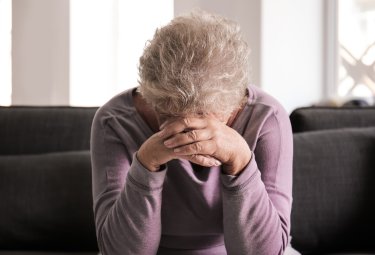Tips for Getting and Staying Active as You Age
May 19, 2025Deciding to be physically active at any age is a positive choice for your well-being and has many important health benefits. As part of an active lifestyle, older adults should include a combination of exercise types. Even small amounts of activity throughout the day count toward the 150 minutes of moderate-intensity aerobic activity and two days of muscle-strengthening activities recommended each week.
Starting and maintaining a change in your routine can be hard. Fortunately, there are strategies to help you increase your physical activity levels. Use these tips for getting and staying active.
Take it slow
It’s important to increase your amount of physical activity gradually over a period of weeks to months. To reduce the risk of injury, start with lower-intensity activities that are appropriate for your current fitness level. Then increase the frequency, intensity, and duration of activities over time. Working your way up slowly and steadily can also help to build confidence, motivation, and a regular routine. When there is a break in your routine, perhaps due to illness or travel, work back up gradually.
Older adults who do not have an existing injury or chronic condition, and who plan to gradually increase their amounts of physical activity, generally do not need to talk with a doctor before becoming physically active. However, for people with or without chronic conditions, doctors and exercise professionals can:
- Assess current physical activity levels
- Provide advice on appropriate types of activities and ways to progress at a safe and steady pace
- Offer continued support through follow-up appointments
As with increasing physical activity, it is also important to be gradual with the exercises themselves. Warming up before exercise and cooling down after exercise is recommended to help prevent injuries and other negative health events, such as heart attack or stroke. A warm-up prepares the muscles for exercise and allows the heart rate and breathing to increase gradually. A cool-down after activity allows a gradual decrease at the end.
Set goals and monitor progress
To help meet your goals, you can track and record your physical activity. Doing so daily can provide valuable information about progress toward achieving weekly physical activity goals. You can use a device (for example, a step counter) or keep a written log. Some people choose to share their activity with a friend, doctor, or exercise professional for further accountability and feedback. Remember to also celebrate successes!
Setting goals for your physical activity can encourage you to achieve increased physical activity levels, starting from your current level. Goals are most useful when they are specific and realistic. This type of goal setting can help update a general goal, such as to increase physical activity, into a measurable and actionable goal, such as to go for a 10-minute walk three times per week. Be sure to review your goals regularly as you make progress.
Identify and overcome barriers
Older adults may face barriers that prevent them from being physically active. Some people don’t know about or have access to safe places to be active, facilities or equipment can be costly, and some people may have concerns about their ability, getting injured, or falling. Other common barriers include time, weather, and interest.
The first step to help overcome obstacles preventing physical activity is to identify potential barriers for you. Problem-solving, potentially with advice from a doctor or exercise professional, can help address the identified barriers with specific solutions. It’s also important to reassess barriers over time, as situations change.
The chart below lists some possible barriers, along with examples of solutions. Apply the same sort of problem-solving to other barriers that might reduce your level of activity.
| Barrier | Solution |
| Bad weather or poor air quality | Find opportunities to walk indoors — at a mall, grocery store, or big-box store. Look for physical activity programs you can access through technology at home, such as doing an online group fitness class through SilverSneakers or the YMCA. |
| Cost and expensive equipment | Try free online videos. Use items you already have at home (such as books or detergent jugs for muscle-strengthening activity). Find ways to add physical activity to your day without special equipment. For example, do household chores, garden, dance, or play with your grandchildren. |
| Too tired or low energy | Plan activity for parts of the day you feel most energetic. Many older adults feel less fatigue during and after physical activity. |
| Lack of motivation, enjoyment, or confidence | Consider working with a personal trainer either individually or in a small group to learn proper form and engage in activity with personalized guidance. Try finding social support and accountability by working out with a buddy or joining a virtual community. |
Build social support
Group-based physical activity, such as exercise classes, walking groups, or “exercise buddy systems,” not only gets you moving, but also provides opportunities for social engagement, friendship, and emotional support. Social support from friends and family can increase motivation and be a key part of success for older adults working toward increasing their activity levels. Encouragement and interaction work well with physical activity!
Engage in a variety of activities
As part of moving more and sitting less each day, older adults should engage in a variety of activities. This approach can make activity more enjoyable and may reduce the risk of overuse injury. Older adults are also recommended to include a combination of aerobic, muscle-strengthening, and balance activities each week.
Activity can be done through exercise, chores, errands, walking or biking for transportation, or leisure-time physical activity. For example:
- Playing pickleball with friends
- Taking the stairs
- Doing work on the yard
- Swimming
- Dancing
- Carrying groceries
- Helping care for grandchildren
- Joining an exercise class
Consider trying both indoor and outdoor activities. Finding multiple ways to build enjoyable activity into your life and participating in activities you enjoy as you age can offer opportunities to increase physical activity.
To learn more, please visit https://www.nia.nih.gov/health/exercise-and-physical-activity/tips-getting-and-staying-active-you-age.




